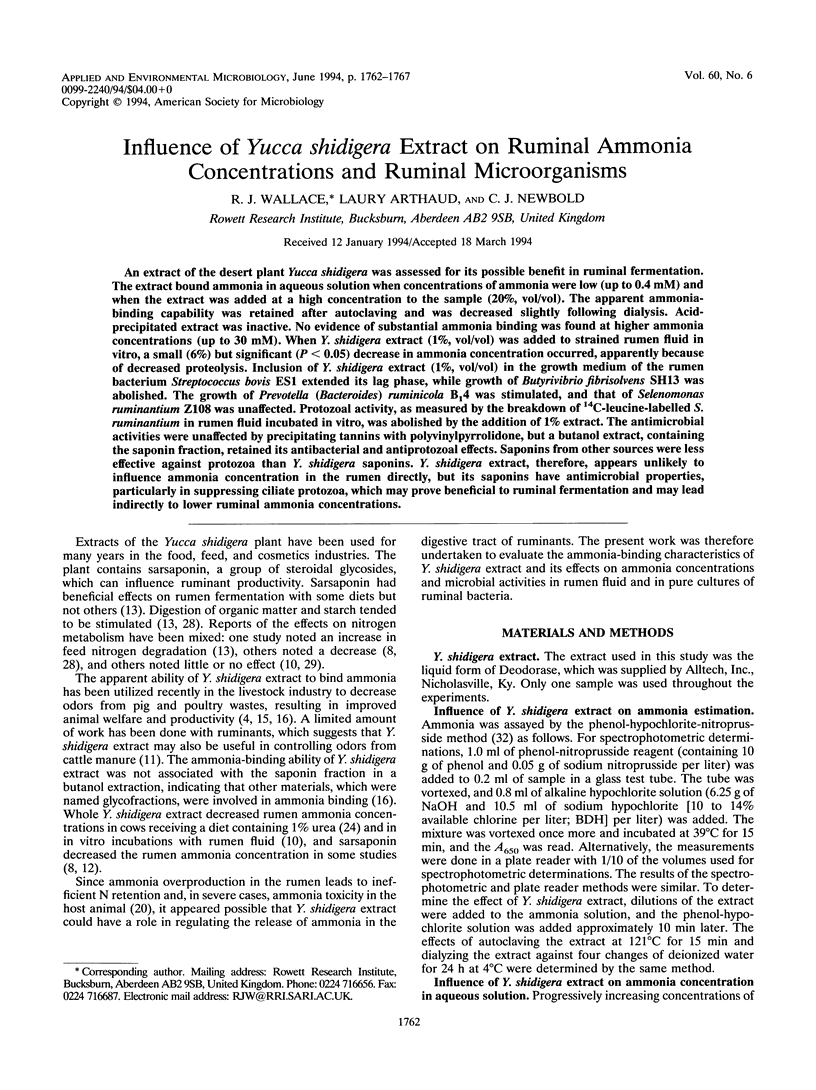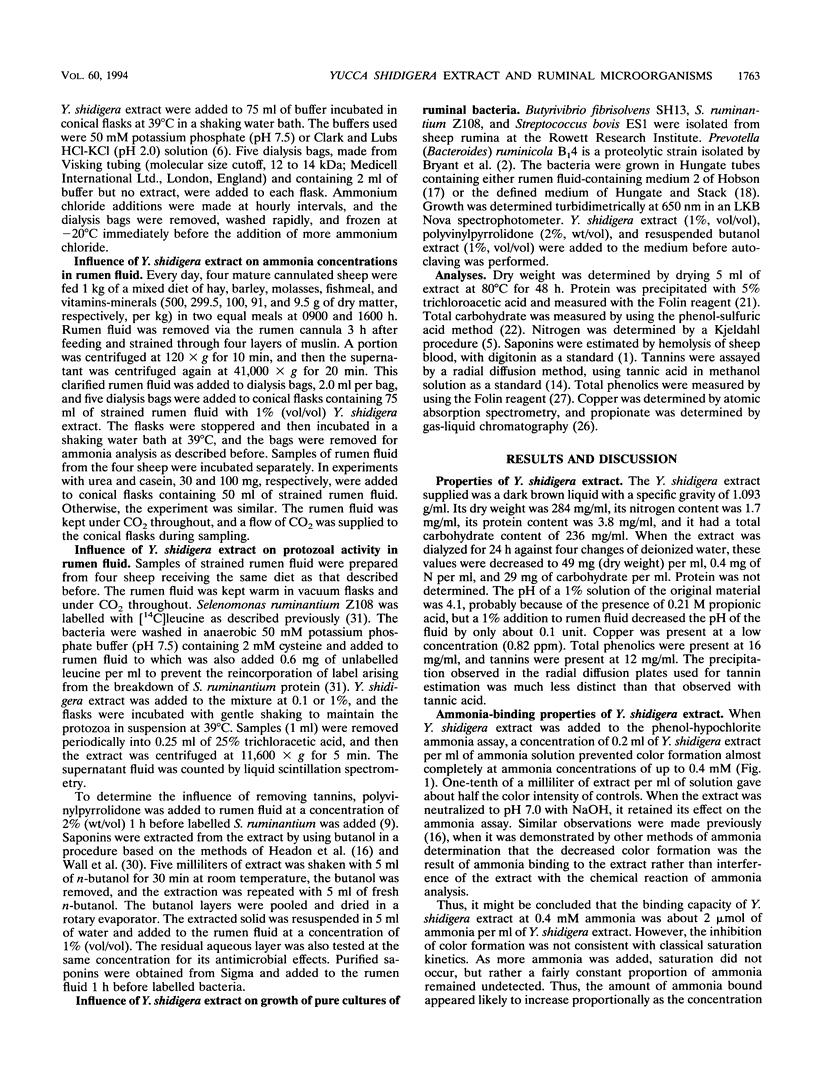Abstract
An extract of the desert plant Yucca shidigera was assessed for its possible benefit in ruminal fermentation. The extract bound ammonia in aqueous solution when concentrations of ammonia were low (up to 0.4 mM) and when the extract was added at a high concentration to the sample (20%, vol/vol). The apparent ammonia-binding capability was retained after autoclaving and was decreased slightly following dialysis. Acid-precipitated extract was inactive. No evidence of substantial ammonia binding was found at higher ammonia concentrations (up to 30 mM). When Y. shidigera extract (1%, vol/vol) was added to strained rumen fluid in vitro, a small (6%) but significant (P < 0.05) decrease in ammonia concentration occurred, apparently because of decreased proteolysis. Inclusion of Y. shidigera extract (1%, vol/vol) in the growth medium of the rumen bacterium Streptococcus bovis ES1 extended its lag phase, while growth of Butyrivibrio fibrisolvens SH13 was abolished. The growth of Prevotella (Bacteroides) ruminicola B(1)4 was stimulated, and that of Selenomonas ruminantium Z108 was unaffected. Protozoal activity, as measured by the breakdown of 14C-leucine-labelled S. ruminantium in rumen fluid incubated in vitro, was abolished by the addition of 1% extract. The antimicrobial activities were unaffected by precipitating tannins with polyvinylpyrrolidone, but a butanol extract, containing the saponin fraction, retained its antibacterial and antiprotozoal effects. Saponins from other sources were less effective against protozoa than Y. shidigera saponins. Y. shidigera extract, therefore, appears unlikely to influence ammonia concentration in the rumen directly, but its saponins have antimicrobial properties, particularly in suppressing ciliate protozoa, which may prove beneficial to ruminal fermentation and may lead indirectly to lower ruminal ammonia concentrations.
Full text
PDF





Selected References
These references are in PubMed. This may not be the complete list of references from this article.
- BRYANT M. P., SMALL N., BOUMA C., CHU H. Bacteroides ruminicola n. sp. and Succinimonas amylolytica; the new genus and species; species of succinic acid-producing anaerobic bacteria of the bovine rumen. J Bacteriol. 1958 Jul;76(1):15–23. doi: 10.1128/jb.76.1.15-23.1958. [DOI] [PMC free article] [PubMed] [Google Scholar]
- Chen M., Wolin M. J. Effect of monensin and lasalocid-sodium on the growth of methanogenic and rumen saccharolytic bacteria. Appl Environ Microbiol. 1979 Jul;38(1):72–77. doi: 10.1128/aem.38.1.72-77.1979. [DOI] [PMC free article] [PubMed] [Google Scholar]
- Davidson J., Mathieson J., Boyne A. W. The use of automation in determining nitrogen by the Kjeldahl method, with final calculations by computer. Analyst. 1970 Feb;95(127):181–193. doi: 10.1039/an9709500181. [DOI] [PubMed] [Google Scholar]
- Demeyer D. I., Van Nevel C. J. Effect of defaunation on the metabolism of rumen micro-organisms. Br J Nutr. 1979 Nov;42(3):515–524. doi: 10.1079/bjn19790143. [DOI] [PubMed] [Google Scholar]
- Goetsch A. L., Owens F. N. Effects of sarsaponin on digestion and passage rates in cattle fed medium to low concentrate. J Dairy Sci. 1985 Sep;68(9):2377–2384. doi: 10.3168/jds.S0022-0302(85)81112-7. [DOI] [PubMed] [Google Scholar]
- Hungate R. E., Stack R. J. Phenylpropanoic Acid: Growth Factor for Ruminococcus albus. Appl Environ Microbiol. 1982 Jul;44(1):79–83. doi: 10.1128/aem.44.1.79-83.1982. [DOI] [PMC free article] [PubMed] [Google Scholar]
- LOWRY O. H., ROSEBROUGH N. J., FARR A. L., RANDALL R. J. Protein measurement with the Folin phenol reagent. J Biol Chem. 1951 Nov;193(1):265–275. [PubMed] [Google Scholar]
- Leng R. A., Nolan J. V. Nitrogen metabolism in the rumen. J Dairy Sci. 1984 May;67(5):1072–1089. doi: 10.3168/jds.S0022-0302(84)81409-5. [DOI] [PubMed] [Google Scholar]
- Schelling G. T. Monensin mode of action in the rumen. J Anim Sci. 1984 Jun;58(6):1518–1527. doi: 10.2527/jas1984.5861518x. [DOI] [PubMed] [Google Scholar]
- Valdez F. R., Bush L. J., Goetsch A. L., Owens F. N. Effect of steroidal sapogenins on ruminal fermentation and on production of lactating dairy cows. J Dairy Sci. 1986 Jun;69(6):1568–1575. doi: 10.3168/jds.S0022-0302(86)80573-2. [DOI] [PubMed] [Google Scholar]
- WALL M. E., KRIDER M. M., ROTHMAN E. S., EDDY C. R. Steroidal sapogenins. J Biol Chem. 1952 Oct;198(2):533–543. [PubMed] [Google Scholar]
- Wallace R. J., McPherson C. A. Factors affecting the rate of breakdown of bacterial protein in rumen fluid. Br J Nutr. 1987 Sep;58(2):313–323. doi: 10.1079/bjn19870098. [DOI] [PubMed] [Google Scholar]


